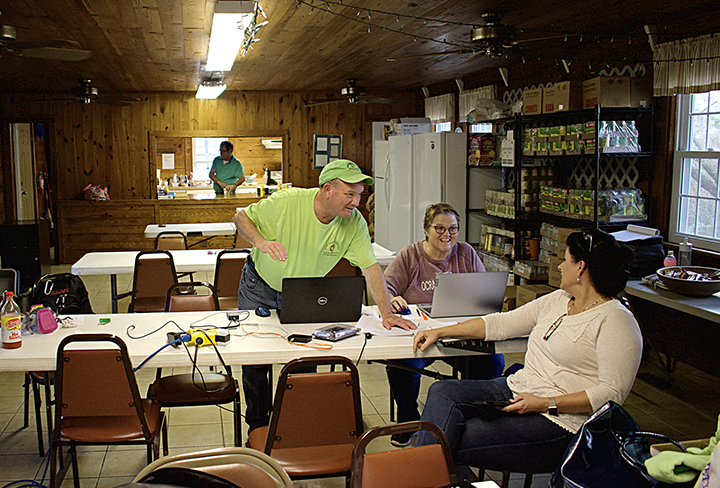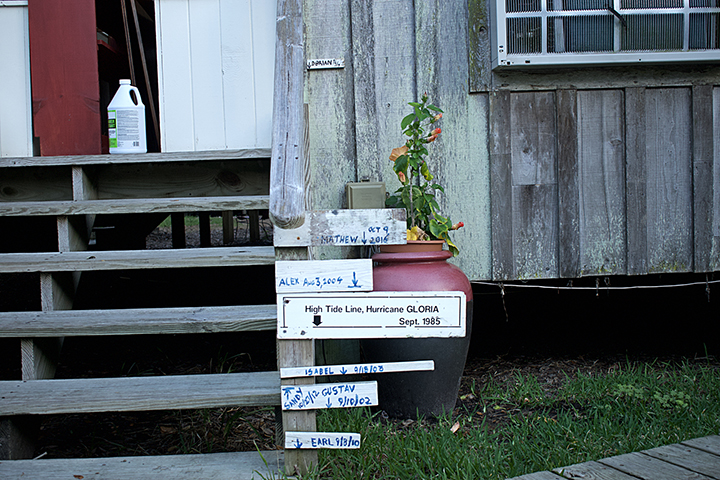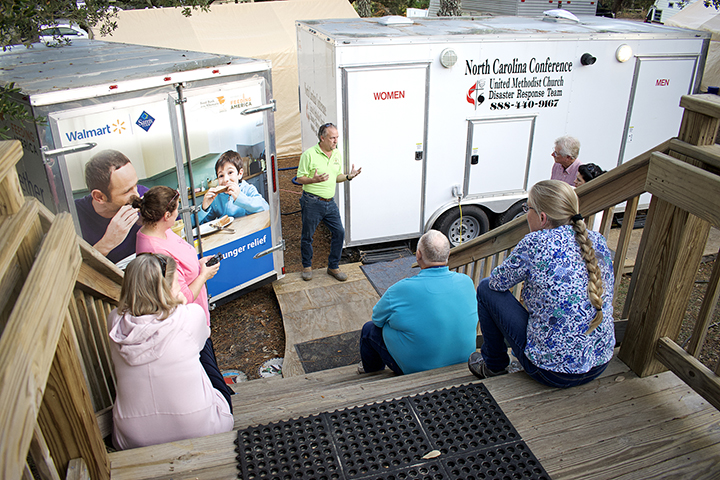
Marcy Brenner’s piano had seen a lot in 111 years, but never anything like the aftermath of Hurricane Dorian on Ocracoke.
The storm surge that Dorian drove into Ocracoke was like none that had been seen before. Wind, waves and storm combined to create an 8- to 9-foot mini-tsunami that pushed flood waters into the village a full foot higher than any previous storm.
Supporter Spotlight
“I knew that this environment could be trouble for the piano but it has weathered storms and humidity and coastal life quite well. I never dreamed I would see it standing in 2 feet of Pamlico sound water,” Brenner said.
The piano is a 1908 Steinway baby grand. It had traveled with Brenner when she left California for a new life in Kitty Hawk and later on Ocracoke Island.
“The piano has become a touchstone, my metaphor for the storm, for life,” she said.
Ocracoke Island is set to reopen to visitors at 5 a.m. Monday, but it’s difficult to describe how complex the recovery from Dorian will continue to be for island residents. With ferries providing the only way on and off the island, there is no possibility for a quick fix.
“Right now one of our biggest problems is getting materials to the island.”
Tom Pahl, Hyde County commissioner
The ride across Pamlico Sound on the state ferries from Swan Quarter or Cedar Island to Silver Lake in the heart of Ocracoke is a two- to two-and-a-half-hour ride, depending on which ferry is taken. Until Sept. 6 when Dorian struck, the trip from Hatteras to Ocracoke was one hour, with the ferry docking on the north end of the island.
Supporter Spotlight
Dorian’s storm surge breached the dunes just south of the terminal, severely damaging N.C. 12, the road from the dock to the village. With the north ferry dock inaccessible, the Hatteras ferry was forced to make a two-and-a half-hour trip to Silver Lake and use an emergency ramp that cannot handle heavy trucks.
The North Carolina Department of Transportation had hoped to reopen the north terminal on Nov. 22, but then a powerful nor’easter Nov. 17-18 washed over the dunes again. The early indication was that it did not damage the road as badly as Dorian, and a tentative reopening date was set for Dec. 6, said David Otts, NCDOT’s resident engineer on the project.
When the weather is good and the visitors line the streets, the tenuous link is a blessing. But now, when the needs of the community are so great, that ribbon of road and strip of sand dunes protecting it highlight how fragile the connection is.
“What most people consider isolation makes it difficult, and only having the sound-route ferries and not even having the Hatteras-route ferry has slowed it (recovery) down tremendously,” said Pastor Ivy Belch of the Ocracoke Assembly of God Church. “If you had the Hatteras-route ferry you could have workers staying in Hatteras and coming and work and go back and have a place to stay … That’s the reality of the situation of what we have here now.”

“Right now one of our biggest problems is getting materials to the island,” said Tom Pahl, the Hyde County commissioner who represents Ocracoke.
His concerns are underscored by Ken Daniels, the owner of Manteo Furniture, who has been supplying Ocracoke with furniture and appliances for years from the store’s Manteo warehouse.
Daniels continues to send his trucks to the island, but every trip entails a 14- to 15-hour day for his employees.
“They try to catch the 6 o’clock (Hatteras ferry) so they have to get to the store by 4:30 so they can get there by 6,” he said. “They get over there and they have four or five hours and they have to catch the ferry to get back. They get back here at 7 and drive home. That’s a long day for people.”
Compounding the supply problem is the emergency ferry ramp that cannot handle large trucks.
“They won’t let us take our big truck on our Hatteras Silver Lake ferry. So we have to use our small truck, which means we can’t put much on it. You can put maybe eight appliances,” Daniels said.
The Swan Quarter ferry can take larger trucks, but the schedule does not work as well for the Manteo Furniture deliveries.
The extent of the damage to homes and businesses here remains unclear. What is known is that almost every structure in Ocracoke Village has been damaged.
Hyde County officials have counted 90 families living in seasonal rental homes that owners have made available. That is a temporary solution. At some point those homes will have to go back into rental programs and there is no assurance that the damaged housing will be ready, although for the time being it seems stable.
“Most of the people that are in that situation, it’s not 100% guaranteed, but it’s mostly through February,” Amy Howard said. Howard, the manager of the Village Craftsman, is a seventh generation Ocracoke native and, like many of her neighbors, she, her husband Dave Tweedie and their son are temporarily homeless.
“I have a place to stay because my dad is not in town. When he comes back to town …” she said.
Howard and other residents are adamant that the Hyde County figure is low. They point out that many of the displaced families are living with friends or relatives and that a more realistic figure is more likely at least 350 people who live on the island are not in their homes.
If that is the case, then 35 to 40% of the village’s housing was uninhabitable after Dorian.
Although the loss of housing is, arguably, the most critical difficulty facing the Ocracoke, it is not the most visible.

More visible are the damaged businesses lining Irvin Garrish Highway as it parallels Silver Lake, a street and waterfront that even during the shoulders of the tourist season are normally filled with tourists sitting by the harbor, sipping a beer with a basket of fish and chips in front of them, or a street filled with visitors strolling by the shops and stopping in from time to time.
It is a devastating economic blow to a village dependent upon tourism for its survival.
“You break even through August,” Howard said. “September, October, November you make your money to live through the year. Essentially we had three days in September. It’s going to hurt. Right now it really hasn’t sunk in.”
What is also visible are the mounds of refuse, lining the road across the highway from Howard’s Pub, which is damaged and closed, or piled into a great hill of the detritus of people’s lives at the Lifeguard Beach parking lot just north of the village.
Removing the mounds of trash left by Dorian will require a Herculean effort. Two, or perhaps three, trucks a day can board the ferries to haul the trash to a transfer station. Pahl pointed out that it is unclear how long it will take to move the last of the rubbish off the island.
“It’s a moving target. There’s still a lot of projects of homes involved in either full demolition of the entire home or demolition related to construction. As they’re getting it hauled out, there’s more being placed, so there’s not really a target,” he said. “The last I heard there was something like 280 to 300 truckloads to be removed from where it’s been staged.”
Although the story of Ocracoke is a tale of disaster, it is also the story of how people view that disaster and move through it.

Pastor Susie Fitch-Slater had just come to the Ocracoke United Methodist Church in July. After the rush of the summer, she thought that perhaps she could relax a bit and read a lot of books. That changed on Sept. 3.
“Dorian came and forever changed our lives,” she said. “I stayed for the storm. Our house on Howard Street was flooded as well. We had to go into the attic because of the flood water. I’m displaced as well. We left the house, and you come to the church hoping to find something better and the pews are upside down and floating, and you open the door and the Bibles and hymnals float out the door.”
“Dorian came and forever changed our lives.”
Susie Fitch-Slater, pastor, Ocracoke United Methodist Church
“I realize now that I spent those first few weeks walking around totally disoriented, totally not knowing where I belong. I have no home; I have no church. Every aspect of life has changed,” she added.
As the days and weeks moved forward, Pastor Susie began to witness a difference in the way people viewed what they were experiencing.
“One of the first things I noticed, when people met each other and asked how they were doing, you didn’t say, ‘Oh you’re going to be OK.’ It was, ‘We’re going to be OK. We are going to get through this,’” she said. “I started to pay attention to that because it was the collective ‘we.’ It was that sharing, which I think made a big difference in everything.”

If there is a shared pride on Ocracoke Island, it is the school. With an enrollment of 185 students, the kindergarten through 12th grade school is a North Carolina School of Excellence. It was also severely damaged by Dorian’s flooding and the building will probably have to be replaced. Classes are now scattered among three locations.
What was lost was more than just classroom space, however. Teachers gather files and information from year to year that helps make them more effective when they are working with students.
“Only three of us did not lose anything. The others lost most of their books and manipulatives (flashcards, blocks and other materials used extensively in primary grades), which is a devastating blow for the primary grades. Files, which have been collected and built upon for years, were flooded and discarded,” said third-grade teacher Martha Taylor.
The teachers have been affected much the same as the rest of the community.
“The students who stayed through the storm have had a life experience they will never forget.”
Martha Taylor, teacher, Ocracoke School
“Sixty percent of the teachers are displaced,” said Mary McKnight, the school’s guidance counselor. “I am displaced, too. We moved in in August. New appliances, the whole thing. After Dorian we had 15 inches of water in the house, and 19 inches in a lower spot.”
Dorian’s biggest effect may be on the students.
“Some of the students are faring better than others, naturally. The students who stayed through the storm have had a life experience they will never forget. Some of them were forced to leave their dwellings as the tide rose higher and higher, being carried, or wading to higher ground as the water pushed through,” Taylor said.
Students’ reactions have varied, with different age groups reacting differently, McKnight noted.
“Middle school is kind of tough in general and then you throw a traumatic event at them. Then you put them all in a non-classroom environment. We’ve seen some tempers flare, just a little bit of lack of self-control, distracted by everything that’s going on around them,” she said.
“High school students immediately went to work for their parents. A lot of those kids were in homes that were flooded, (and are busy) running errands for their parents,” she said. “But middle-schoolers are in that awkward, in-between age where you’re maybe not old enough to do some of the hard stuff but you’re too old to just be babied and taken care of.”

Ocracoke remains under the evacuation order issued Sept. 3 in advance of Dorian, open only to residents, property owners, emergency workers and by permit only. But Hyde County commissioners voted 4-1 on Nov. 20 to reopen Ocracoke to all visitors effective Dec. 2.
The decision was controversial, and Pahl, who voted to reopen the island, acknowledged that not everyone on Ocracoke Island agreed with his decision.
“It has been a little bit contentious. This is true about everything that we’re dealing with. But I get way more thanks than people yelling at me. It’s really easy to let the negative overwhelm the positive. But there’s a lot of positive,” he said.
Chip Stevens, the owner of Blackbeard’s Lodge, traces his family roots to the days of Blackbeard. He said lifting the evacuation order was premature. Of particular concern is that an influx of visitors could slow the recovery time, pushing repairs into spring when a larger flow of visitors can be expected to arrive.
“It’s … about the island and how quickly we can get up and running again,” he said. “Let’s say you’re a town anywhere – in Iowa – and there’s an earthquake. All of a sudden, every single route into the town, each one is only open for two-hour increments. And you’ve got to get all your stuff in and at the same time you have to rebuild everything. That’s kind of where we are. We have to get all this crap off and we’ve got to get 1.3 times back on to rebuild.”
NCDOT estimates that the Hatteras Inlet ferry route and the stretch of N.C. 12 that extends to the north end of the island will be available again by Dec. 6. The opening of the route to the north should speed recovery, but scope of the damage is so great that the effects of Dorian will linger for months.
“How the island was affected this time with all the residents who were displaced from their homes and the damage that has taken place to home structures business structures, every word of devastating, every syllable you can pronounce of it has been that for Ocracoke,” Pastor Ivy said. “From a personal standpoint of growing up on Ocracoke – my family is from here on my mom’s side – it is devastating. And on top of that, being a pastor and looking at it from that perspective, in your mind you really can’t move quick enough. That’s the most devastating part of it.”








